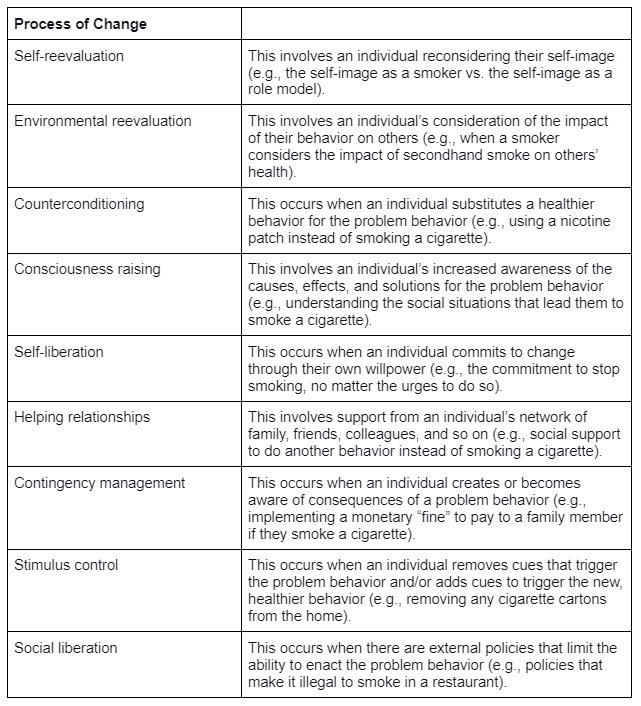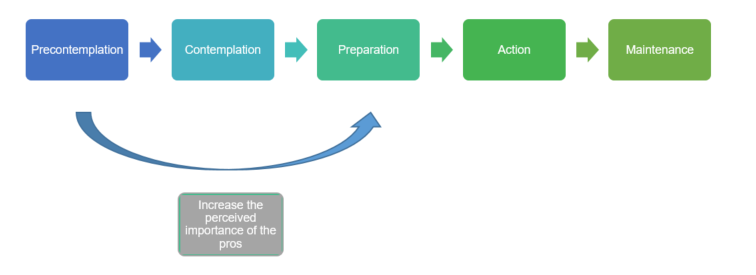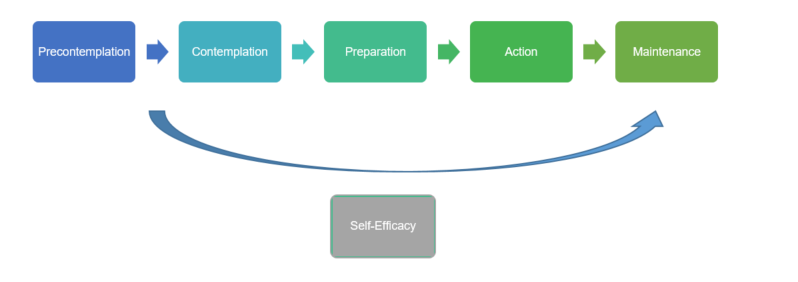8 Transtheoretical Model
Kagen S. Silver & Amber K. Worthington
The goal of persuasion is to change behavior. We all know that changing behavior is hard. For example, how many of us have set New Year’s resolutions and broken those same resolutions three weeks later? The Transtheoretical Model (Prochaska & DiClemente, 1983; Prochaska, Redding, & Evers, 2002) is a stage model of behavior change that posits that behavior change involves moving through a sequence of distinct stages. The Transtheoretical Model creates a comprehensive concept of change that can be applied to various behaviors, environments, and individuals. The Transtheoretical Model sees the behavior change process occurring through five distinct stages: Precontemplation, Contemplation, Preparation, Action, and Maintenance with the possibility for relapse, as depicted below. Together, the Transtheoretical Model refers to these stages as the Stages of Change.

The Stages of Change
The Transtheoretical Model claims that, when making behavioral changes, individuals pass through each stage at a varying pace subject to the behavior being changed, the environment, and the individual themselves. No stage is subject to any particular timeline; stages can last from as little as one hour to as long as a lifetime. Despite being displayed as a linear model, behavioral change is often nonlinear; progression and regression are common in stages of change. People may move forward, backward, and slide back and forth between stages in a complex and dynamic way. People do not, however, skip any stages; thus people move through this general sequence when changing behavior.
Precontemplation
Those in the precontemplation stage do not intend to conduct any action in the immediate future. Being unaware of one’s behaviors is a consequence of being in the precontemplation stage. While in this stage, individuals will defend their behavior and may become defensive when faced by efforts to pressure them to change. For example, someone who smokes in this stage is not even considering or thinking about quitting smoking.
Contemplation
In the contemplation stage, individuals are aware of their behavior’s personal consequences and are thinking about possibly changing in the future. In this stage, individuals are more open to new information and are aware of the pros of changing but are still more aware of the negative aspects of change. Individuals can spend a day, a week, or years in the contemplation stage balancing the pros and cons of changing their behavior, and this ambivalence can be identified as behavioral procrastination. Those in this stage may make statements such as “I know I have a problem” or “I should probably do [insert behavior].” For example, someone who smokes in contemplation is thinking about quitting and weighing the pros and cons of doing so.
Preparation
In the preparation stage, individuals have committed to change. They will easily be able to acknowledge their problematic behavior and are committed to changing it. In this stage, the individual is aware that the positive aspects of change outweigh the negative and are actively looking for information to help them. In this stage, insufficient planning can result in greater challenges in the future, which may lead to relapse. For example, someone who smokes in the preparation stage plans to quit and is actively taking steps to do so (e.g., buying nicotine alternatives).
Action
During the action stage, individuals are actively involved in changing their behavior. They are open to receiving assistance from others. People in this stage are teeming with confidence as they believe they have the personal willpower to take on the process of change. Short term positive reinforcements of change are often established to keep individuals motivated to change. Individuals continue to plan to overcome potential challenges on the journey to behavioral change. For example, in the action stage, someone who used to smoke has now quit smoking.
Relapse
Relapse occurs when an individual returns to the problematic behavior such as beginning to smoke or drink again. Relapse is not a stage, but can occur at any stage during the process. Those trying to change highly addictive behaviors such as drinking, smoking, and drug use are at higher risk of relapsing. Relapse can be avoided with proper support networks and plans to prevent relapse.
Maintenance
The maintenance stage is determined by total abstinence from the changed behavior and the ability to avoid any temptations to return to the previous behavior. In this stage, individuals can remind themselves of the progress they have made, which helps reinforce the changes in behavior. Thoughts of returning to the previous behavior may arise, but the individual is able to resist temptations to do so due to proper planning and positive changes. For example, in this stage, someone who used to smoke has not only quit smoking, but is easily able to maintain that status.
How do people progress through the stages of change?
The Transtheoretical Model proposes that people progress through these stages of change using processes of change. Prochaska, Redding, and Evers (2002) provide several examples, which are depicted in the table below. The Transtheoretical Model states that different processes of change are relevant and effective during different stages of change; however, criticism of the Transtheoretical Model has noted that it is not clear which processes of change apply to which stage of change (see O’Keefe, 2016).

How can the Transtheoretical Model be used to create persuasive messages?
The Transtheoretical Model indicates that people at different stages of change will be motivated by different message content. For example, a smoker in precontemplation likely needs different information to move to contemplation than a smoker in action needs to move to maintenance. It is therefore important to determine how to develop persuasive messages and interventions that are matched to an individual’s stage of change. O’Keefe (2016) notes that decisional balance and self-efficacy are important to create stage-matched persuasive messages.
Decisional Balance
Decisional balance is an individual’s belief that they have the ability to perform a new behavior that will or has substituted a problem behavior. As people progress through the stages of change, the pros of behavior change will outweigh the cons. This decisional balance can be assessed with a questionnaire where a participant is asked to rate the importance of various pros and cons on their behavior change. An example is shown here, where the first item assesses a pro and the second item assesses a con:

The importance of these pros and cons do vary depending on an individual’s stage of change. Di Noia and Prochaska (2010) state: “The balance between the pros and cons varies across stages. Because individuals in precontemplation are not intending to take action to change a behavior, the cons outweigh the pros in this stage. [The importance of the] pros increase and [the importance of the] cons decrease from earlier to later stages. In action and maintenance stages, the pros outweigh the cons. A crossover between the pros and cons occurs between precontemplation and action stages” (p. 619). Note that the research on decisional balance has examined the changes in perceived importance of various pros and cons across the stages of change, not the number of perceived pros or cons (O’Keefe, 2016).
Decisional balance therefore may have an important role in designing persuasive messages using the Transtheoretical Model. For example, an effective message to move individuals from precontemplation to contemplation to action could attempt to increase the perceived importance of the pros of changing the problem behavior (see Prochaska et al., 2002). O’Keefe (2016), however, notes that the fact that decisional balance is related to various stages of change does not necessarily mean that decisional balance was the cause of movement from one stage to the next. Thus, other strategies should also be considered when designing a persuasive message.

Self-Efficacy
Self-efficacy is an individual’s belief that they have the ability to perform and maintain a new behavior that will or has substituted a problem behavior. Self-efficacy can be assessed with a questionnaire where a participant is asked to rate how easy they believe adopting the new behavior would be. An example is shown here.

The Transtheoretical Model indicates that messages designed to increase self-efficacy are not effective at earlier stages (e.g., precontemplation), because people have not yet decided to change their behavior. As O’Keefe (2016) notes: “…until people have become convinced of the desirability of an action, there is little reason to worry about whether they think they can perform the behavior” (p. 137). Some studies have found support for this idea. For example, Prentice-Dunn, McMath, and Cramer (2009) found that self-efficacy information about the ease of using sunscreen did not move people from precontemplation to contemplation but did move people from contemplation to preparation. Other studies, however, have found that self-efficacy information is effective at all stages. For example, Schwarzer, Cao, and Lippke (2010) found that self-efficacy information about how to exercise was effective at moving people along the stages, even at the early stages. Self-efficacy information may therefore have an important role in designing persuasive messages using the Transtheoretical Model, potentially at all stages.

Criticism of the Transtheoretical Model
It is important to note that there are several important criticisms to consider when planning to use the Transtheoretical Model. First, some have raised concerns about the description and procedures for assessing various stages of the Transtheoretical Model (see O’Keefe, 2016). Typically, an individual’s stage has been assessed using answers to a series of yes-no questions about current behavior, thoughts about change, intentions to change, and so on. Some of the resulting stage classifications can seem artificial or vary from study to study. Second, there is a general lack of empirical work testing the idea that a persuasive message is most effective when targeted at individuals in a particular stage, and more research is needed in this area. Finally, some have argued that the Transtheoretical Model’s stages may not constitute mutually exclusive categories (see O’Keefe, 2016), and people’s intentions and behaviors may be better suited for an approach that sees these transitions along a continuum.
References
Di Noia, J., & Prochaska, J. O. (2010). Dietary stages of change and decisional balance: A meta-analytic review. American Journal of Health Behavior, 34(5), 618-632.
O’Keefe, D. J. (2016). Persuasion: Theory and Research (Third Edition). Thousand Oaks, CA: Sage Publications.
Prentice-Dunn, S., Mcmath, B. F., & Cramer, R. J. (2009). Protection motivation theory and stages of change in sun protective behavior. Journal of Health Psychology, 14(2), 297-305.
Prochaska, J. O., & DiClemente, C. C. (1984). The transtheoretical approach: Crossing traditional boundaries of therapy. Homewood, IL: Dow Jones-Irwin
Prochaska, J. O., Redding, C. A., & Evers, K. E. (2002). The transtheoretical model and stages of change. In K. Glanz, B. K. Rimer, & F. M. Lewis (Eds.), Health behavior and health education: Theory, research, and practice (3rd ed., pp. 99-120). San Francisco, CA: Jossey-Bass.
Schwarzer, R., Cao, D. S., & Lippke, S. (2010). Stage-matched minimal interventions to enhance physical activity in Chinese adolescents. Journal of Adolescent Health, 47(6), 533-539.

